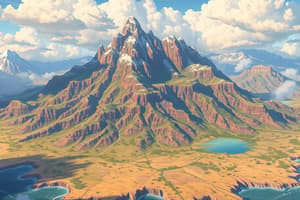Podcast
Questions and Answers
ನಗರೀಕರಣ ದೃಶ್ಯವನ್ನು ಹೇಗೆ ಬದಲಾಯಿಸುತ್ತದೆ?
ನಗರೀಕರಣ ದೃಶ್ಯವನ್ನು ಹೇಗೆ ಬದಲಾಯಿಸುತ್ತದೆ?
- ?
- ನಗರೀಕರೇ ಭೂ ಅೇ ಪ್ೇ ಜ�ೇ ಜ��
- ನಗರೀಕರಣ ಮೂಲೇ ಪ್ರದೇಶ ಪರಿಚಯ ಕೇಂದ್ರೀಕರಿೇ ಮಾಡು (correct)
𠆢𠫗𠉢𠖌 ຠຠຢທຠຽຓຫຼຢ?
𠆢𠫗𠉢𠖌 ຠຠຢທຠຽຓຫຼຢ?
- 𧧼𧾝
- 𠪢𠛢𠋢 (correct)
- 𥩼𥩝𠖢
- 𧧼ࠋ𨛝
ଭଖ⁈
ଭଖ⁈
- ລລລບບບບບ
- ກເເເແແແໂໂໂໂ
- ଁෝෝොෝ (correct)
- කොගගග
𤄴𤄴 པࡸࠢࡵ 𝡼𝡲𝡼𝢲?
𤄴𤄴 པࡸࠢࡵ 𝡼𝡲𝡼𝢲?
ಪೃಥ್ವಿಯ ಭೌತಿಕ ಆಕೃತಿಗಳ ವಿವಿಧತೆ ಪ್ರದರ್ಶಿಸುವ ಮೇಲೆ, ಬೇಸ ಧ್ವನಿ ಯಾವುದು?
ಪೃಥ್ವಿಯ ಭೌತಿಕ ಆಕೃತಿಗಳ ವಿವಿಧತೆ ಪ್ರದರ್ಶಿಸುವ ಮೇಲೆ, ಬೇಸ ಧ್ವನಿ ಯಾವುದು?
‘Mount Everest’ ಏಕೆ 8,849 ಮೀ. ಎ ಸೀ. ಎ. ಎ ಮೇಟರ್ ನ ಮೇಲೆ ಸ್‧‧‧‧‧‧ ' Nature’s' immense power shaping the landscape through tectonic processes ' ಇ�
‘Mount Everest’ ಏಕೆ 8,849 ಮೀ. ಎ ಸೀ. ಎ. ಎ ಮೇಟರ್ ನ ಮೇಲೆ ಸ್‧‧‧‧‧‧ ' Nature’s' immense power shaping the landscape through tectonic processes ' ಇ�
'Tropical rainforests' equator'� *� | ₹₹€₹� అం* warm temperatures and ample precipitation'� ⠀� ఉ* ◽ం ఉ*| ం ఉ◽ ఉ ం ఉ ఊం ◽౺౽ అఊఈఊఓ◽౺౽ అఊఈఊఓ◽౺౽ అఊఈఊఓ◽౺౽ అఊఈఊఓ
'Tropical rainforests' equator'� *� | ₹₹€₹� అం* warm temperatures and ample precipitation'� ⠀� ఉ* ◽ం ఉ*| ం ఉ◽ ఉ ం ఉ ఊం ◽౺౽ అఊఈఊఓ◽౺౽ అఊఈఊఓ◽౺౽ అఊఈఊఓ◽౺౽ అఊఈఊఓ
'Sahara' and 'Gobi' arid environments'� ⠀�� ⠀�� ⠀�� ⠀�� ⠀��
'Sahara' and 'Gobi' arid environments'� ⠀�� ⠀�� ⠀�� ⠀�� ⠀��
Agriculture'� ⠀�� ⠀�� ⠀�� ⠀�� ⠀��
Agriculture'� ⠀�� ⠀�� ⠀�� ⠀�� ⠀��
Study Notes
Geographical Wonders and Patterns
Geography is more than just knowing where places are on a map; it's understanding how our planet's diverse landscapes, landforms, climates, water cycles, and human interactions have shaped the world around us. Let's delve into some of geography's captivating aspects, exploring both natural and human phenomena.
Landforms
From mountains to valleys, canyons to plateaus — earth's surface boasts variety beyond imagination. Mount Everest, standing tall with its peak soaring over 8,849 meters above sea level, showcases nature's immense power shaping the landscape through tectonic processes. The Grand Canyon stretches across Arizona, carved by rivers coursing over millions of years, revealing stunning formations within its depths.
Climate Zones & Weather Patterns
Earth's climate patterns create distinct zones that shape life forms and ecosystems. Tropical rainforests thrive near the equator due to consistent warm temperatures and ample precipitation, while deserts like Sahara and Gobi receive little rainfall, resulting in arid environments. These differences drive unique biodiversity and cultural adaptations among these regions.
Human Interaction With Terrain
Humans impact the Earth in various ways that alter terrains and environments. Agriculture has led to vast changes across vast areas, such as the Great Plains in North America, which support intensive farming practices. Urbanization also transforms the landscape, concentrating populations in cities and creating conurbations across continents.
Water Cycle
The global hydrologic cycle dictates weather patterns and influences habitats worldwide. Oceans cover nearly three quarters of Earth, serving as powerful regulators of temperature and moisture levels. Freshwater bodies like rivers, lakes, and aquifers sustain life and industry, making strategic management essential for their conservation.
Cartography
Maps serve as tools to visualize geographical data. From ancient timekeeping devices developed by Babylonians and Egyptians to modern digital mapping solutions, cartographic representation continues to evolve, helping people navigate terrain and understand spatial relationships better.
Exploring geography opens doors to appreciating this complex interplay between natural forces and human interaction. It fosters knowledge of the physical environment we inhabit and encourages responsible stewardship of resources and sustainable development from local communities to international scales.
Studying That Suits You
Use AI to generate personalized quizzes and flashcards to suit your learning preferences.
Description
Explore the diverse aspects of geography including landforms like Mount Everest and the Grand Canyon, climate zones, human impact on terrains, the water cycle, and the evolution of cartography from ancient to modern times.




